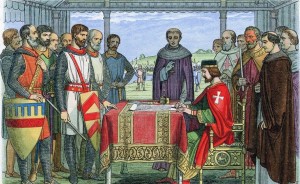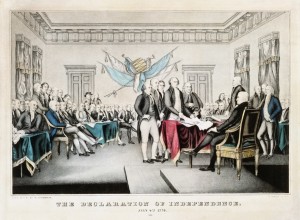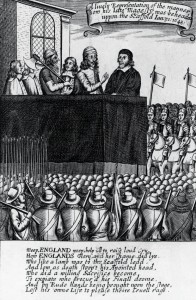Nelson Mandela appealed to it; the US founding fathers drew on it; Charles I’s opponents cherished it. David Carpenter considers the huge significance of the 13th-century document that asserted a fundamental principle – the rule of law

On the dotted line: King John signing Magna Carta at Runnymeade 15 June 1215. Photograph: Universal History Archive/Un/REX
This year, 2015, is the 800th anniversary of Magna Carta. It was on 15 June 1215 that King John, in the meadow of Runnymede beside the Thames between Windsor and Staines, sealed (not signed) the document now known as the Magna Carta. Today, jets taking off from London Heathrow airport come up over Runnymede and then often turn to fly down its whole length before vanishing into the distance. Yet it is not difficult to imagine the scene, during those tense days in June 1215, when Magna Carta was being negotiated, the great pavilion of the king, like a circus top, towering over the smaller tents of barons and knights stretching out across the meadow.
The Magna Carta is a document some 3,550 words long written in Latin, the English translation being “Great Charter”. Much of it, even in a modern translation, can seem remote and archaic. It abounds in such terms as wainage, amercement, socage, novel disseisin, mort d’ancestor and distraint. Some of its chapters seem of minor importance: one calls for the removal of fish weirs from the Thames and Medway. Yet there are also chapters which still have a very clear contemporary relevance. Chapters 12 and 14 prevented the king from levying taxation without the common consent of the kingdom. Chapter 39 laid down that “No free man is to be arrested, or imprisoned, or diseised [dispossessed], or outlawed, or exiled, or in any way destroyed, nor will we go against him, nor will we send against him, save by the lawful judgement of his peers or by the law of the land.”
In chapter 40 the king declared that “To no one will we sell, to no one will we deny or delay, right or justice.”
In these ways, the Charter asserted a fundamental principle – the rule of law. The king was beneath the law, the law the Charter itself was making. He could no longer treat his subjects in an arbitrary fashion. It was for asserting this principle that the Charter was cherished by opponents of Charles I, and called in aid by the founding fathers of the United States. When on trial for his life in 1964, Nelson Mandela appealed to Magna Carta, alongside the Petition of Rights and the Bill of Rights, “documents which are held in veneration by democrats throughout the world”. Chapters 39 and 40 are still on the statute book of the UK today. The headline of a Guardian piece in 2007 opposing the 90-day detention period for suspected terrorists was “Protecting Magna Carta”.

The founding fathers sign The Declaration of Independence. Photograph: Museum of the City of New York/Corbis
The anniversary has inspired a great deal of scholarly work. The Magna Carta Project has made many new discoveries, and numerous public events are planned. In February all four surviving originals of the 1215 Charter, are being brought together for the first time, and will be displayed first at the British Library and then in the Houses of Parliament. The British Library is putting on an exhibition, Magna Carta: Law, Liberty, Legacy, which traces the history of the document from its origins to the present day. Apart from numerous documents and artefacts from the Charter’s first century, the exhibits will include the first printed edition of Magna Carta published in 1508, so small that it can fit into the palm of your hand, Thomas Jefferson’s handwritten copy of the Declaration of Independence (1776), and the Delaware copy of the United States Bill of Rights (1790). On the anniversary itself, there will be a great ceremony at Runnymede. If members of Her Majesty’s government attend, let us hope they remember that the Charter was aimed at the activities of their forebears.
In 1215 there was nothing new in the ideas behind the Charter. They were centuries old and part of general European heritage. Strengthened in the 12th century by the study of Roman and canon law, they can be found in legislation and constitutions promulgated in Spain, Hungary and the south of France. It was in England, however, that they led to the most radical and detailed restrictions on the ruler. That was because in England the ruler was uniquely demanding and intrusive, thanks to the pressures of maintaining a continental empire, which stretched from Normandy to the Pyrenees. By the time of John’s accession in 1199, there was already outcry at the level of the king’s financial demands. They were to become far worse.
After John had lost Normandy and Anjou to the king of France in 1204, he spent 10 years in England amassing the cash needed to recover his empire, in the process tripling his revenues. In 1214 the eventual campaign of recovery ended in total failure. John returned to England, his money spent and his prestige in tatters. Next year his baronial enemies rebelled and forced him to concede Magna Carta. Their grievances were not just financial. Although paying lip service to the principles of custom and consent, John’s rule had been lawless. He took hostages at will, deprived barons of lands and castles without legal process, and demanded large sums of money to assuage his rancour and recover his goodwill. In a chivalrous age, which expected noble captives to be treated with courtesy, he was cruel. He murdered both his nephew Arthur and the most famous woman of the age, Matilda de Briouze. She and her eldest son were starved to death in the dungeons of Corfe castle. As a contemporary writer put it, John was “brimful of evil qualities”.

The execution of King Charles I – whose opponents cited the Magna Carta – at Whitehall on 30 January 1649. Photograph: Alamy
In 1215, John was, therefore, placed beneath the law, but the Magna Carta of 1215 was very far from giving equal treatment to all the king’s subjects. Socially it was a divided and divisive document, often reflecting the interests of a baronial elite a few hundred strong in a population of several millions. Having asserted that taxation required the common consent of the kingdom, the assembly giving that consent was to be attended primarily by earls, barons, bishops and abbots. There was no place for London and other towns, although the Londoners thought that there should be. There was no place for knights elected by and representing the counties, although the Charter elsewhere assigned important roles to elected knights. In other words, there was no equivalent of the House of Commons.
At least, in the chapter on taxation, the good and great of the realm could be seen as protecting the rest of the king’s subjects from arbitrary exactions. But the king’s subjects were far from sharing equally in the Charter’s benefits. Indeed, the unfree villeins, who made up perhaps half the population, did not formally share in those benefits at all. The liberties in the Charter were granted not to “all the men” of the kingdom, but to “all the free men”. It was likewise only freemen who were protected from arbitrary imprisonment and dispossession by chapter 39.
As far as Magna Carta was concerned, both king and lords remained perfectly free to dispossess their unfree tenants at will. The threat of doing so was a vital weapon for control of the peasant workforce. Chapter 40’s “To no one will we deny, delay or sell right or justice” seemed more inclusive. But this was less helpful to the unfree than it seemed. It was the law itself that laid down that villeins had no access to the king’s courts in any matter concerning their land and services. These were entirely for the lord to determine. As one lawbook put it, “a villein when he wakes up in the morning, does not know what services he must perform for his lord by night”. The one chapter in the Charter which specifically protected the unfree was less than it seemed. Under chapter 20, fines imposed on villeins were to match the offence and be assessed by local men. During the negotiations at Runnymede, this chapter was redrafted to make it clear that the fines in question were those imposed by the king. In other words, they did not apply at all to fines imposed by lords.
Magna Carta also reflected the inequalities between men and women, and in particular the way women played a very limited part in public affairs. The Charter gives the names of 34 men. Three women are mentioned: John’s queen, and the sisters of King Alexander II of Scotland. Not one was named. It is true that “man” could be understood at the time of the Charter to mean simply “human being”. The “no freeman” of chapter 39 thus protected free women. Indeed, the chapter owed something to the way John had “destroyed” Matilda de Briouze.

Nelson Mandela, who referred to the Magna Carta during his 1964 trial. Photograph: Alexander Joe/AFP/Getty
But the chapter also demonstrated the inequalities between the sexes. If a free woman secured judgment of her peers (that is social equals), under its terms those peers would have been entirely male for women did not sit on juries. Chapter 39 also forgot about women altogether when it spoke of outlawry, for women were not outlawed they were “waived”, which meant left as a “waif”. This had the same effect. A waived woman could be killed on sight just like an outlawed man. But the distinction showed how subject women were to men. Women took no oath of allegiance to the king because in theory they were always under the protection of a man – father, husband or lord. They were, therefore, never “in law” and so could not be “oulawed”, hence they were “waived” instead.
In 1215 itself both John and his enemies would have been astonished had they known that the Charter would live on and be celebrated 800 years hence. Especially as within a few months of its promulgation, Magna Carta seemed a dead letter. John had got the pope to quash it. (The magnificent papal bull in which he did so is a star exhibit in the British Library exhibition.) The barons, likewise abandoning the Charter, deposed John and elected another king in his place, none other than Prince Louis, the eldest son of the king of France. The Charter only survived because, after John’s death in October 1216, the minority government of his son, the nine-year-old Henry III, accepted what John had rejected. In order to win the war against Louis, and, having won the war, consolidate the peace, they issued new versions of the Charter. Then, in 1225, in order to secure a great tax, they issued what became the final and definitive Magna Carta. It is chapters of Henry III’s Charter of 1225, not John’s of 1215, which remain on the Statute Book. Indeed in the 13th century, it was Henry’s Charter of 1225 which was called “Magna Carta”; John’s Charter of 1215 was more often called just “the Charter of Runnymede”. The name Magna Carta itself had only appeared in 1218 to distinguish the Great Charter from the smaller Charter dealing with the royal forest which Henry III issued alongside it. It was not till the 17th century that John’s Charter recovered its place centre stage and became called Magna Carta. That, however, was fair enough for in its essence and in much of its detail the Charter of 1225 replicated that of 1215. Without John’s Charter, there would have been no Charter of Henry III.
In 1215 Magna Carta was an elitist document, yet by the end of the 13th century it had become known across society, and all sections of society, legitimately or not, were laying claim to its benefits. The originals issued between 1215 and 1225, and subsequent confirmations, spawned numerous copies, thanks in large part to the activities of the church whose liberty was protected in chapter one. Such was the thirst for knowledge of the Charter that many of the copies were of unofficial versions derived from drafts made at Runnymede. Already in 1215 itself the Charter had been translated from Latin into French, the vernacular language of the nobility. By the end of the 13th century the Charter was being proclaimed in English, the language of everyone else.
In around 1300, the peasants of Bocking in Essex (later a centre of the 1381 peasants’ revolt) appealed to Magna Carta in a struggle against their lord’s bailiff. In the 1350s, legislation defined the “no free man” as “no man of whatever condition”. The Charter seemed increasingly to have a universal application. It had established the base from which it would go around the world. Its appeal lay not in its precise details, but in its assertion of the rule of law. Everything is of its own time, but only some ideas are taken up and spread. When human rights are still trampled on in many parts of the world, what happened in a meadow by the Thames 800 years ago retains its significance. Let us hope Magna Carta will still be celebrated 100 years from now.
David Carpenter’s new translation of Magna Carta is published as a Penguin Classic.


Pingback: Aula 02 – Direito Tributário – 26.02.15 | Projeto Pasárgada